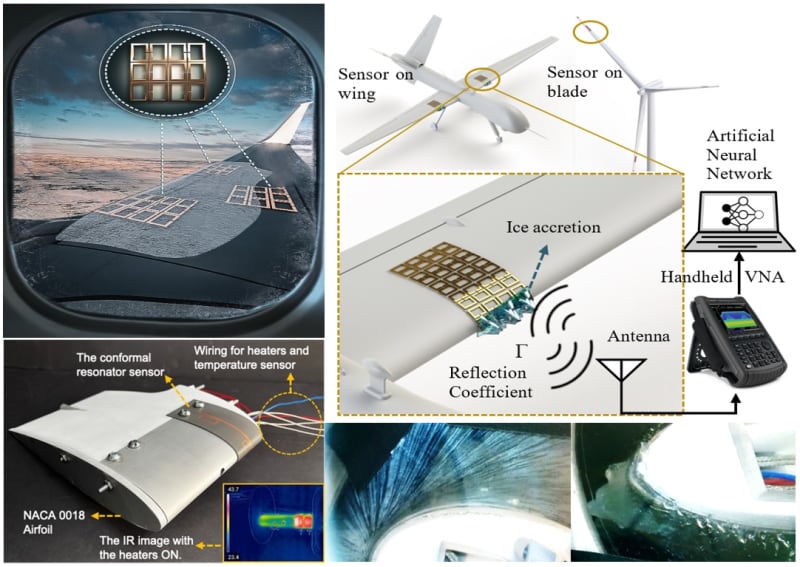
In-flight ice accretion poses a persistent challenge to airplane safety by disrupting wing aerodynamics, leading to increased drag and reduced lift. Ice and snow are common experiences for a large segment of the global population, with over 31% of the Earth's landmass undergoing seasonal snow and ice accretion (as illustrated by a satellite image of global snow cover in February 2022). In the United States alone, ice and snow affect 70% of the population, resulting in over 1,300 annual deaths from icing-related roadway accidents and an estimated US$2.3 billion spent annually on roadway snow and ice control operations.
This work introduces a conformal ice sensing method utilizing microwave split ring resonator (SRR) sensors for the early detection of ice on critical aircraft surfaces. The design presents an ice detection system comprising a battery-free, chip-less, wirelessly interrogated resonator array, paired with an artificial neural network to enhance detection robustness. The designed array of split-ring resonators (SRRs), operating at 3.05 GHz, forms a narrowband frequency-selective structure with a ground plane reflector to shield resonance from installation material effects. When an incident wave induces the array’s surface, the reflection coefficient changes based on the electrical properties of ice and water, thus affecting the S11 parameter of an interrogator antenna. The array, with a surface area of 13×6.5 cm² and a substrate thickness of 0.79 mm, was wirelessly interrogated from a distance of 33 cm using a standard gain horn antenna. The artificial neural network then classified the reflection coefficients to improve ice/water differentiation. This neural network enhanced raw data classification accuracy to 94.67%, and achieved 93.33% accuracy with noisy data sets.
The SRR was implemented and integrated on a NACA 0018 airfoil with a 0.25 m chord. The sensor's performance was experimentally evaluated under ice crystal icing (ICI) conditions at the National Research Council's (NRC) Research Altitude Test Facility (RATFac), at a simulated altitude of 19,000 ft, a velocity of 100 m/s, and a total air temperature of +3˚C. The sensor's performance was assessed using the resonant frequency parameter to establish correlations under various icing conditions. The sensor was tested in different melt ratio conditions (11%, 13%, 16%, and 25%) at varying accretion time periods, accurately determining the onset of icing, the increase in accretion volume, and its eventual shedding, while successfully differentiating the %melt conditions tested.
-
Awards
-
 2024 Top 100 Entries
2024 Top 100 Entries
Like this entry?
-
About the Entrant
- Name:Mohammad Zarifi
- Type of entry:teamTeam members:
- Omid Niksan
- Fatemeh Niknahad
- Aaryaman Shah
- Mohammad Zarifi
- Patent status:pending

